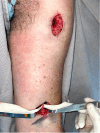A prospective cohort study: promising results with minimally invasive plate osteosynthesis of anterior bridge plating in adult humeral shaft fractures
- PMID: 39523785
- PMCID: PMC11615461
- DOI: 10.5397/cise.2024.00423
A prospective cohort study: promising results with minimally invasive plate osteosynthesis of anterior bridge plating in adult humeral shaft fractures
Abstract
Background: Adult humeral shaft fractures have traditionally been managed conservatively, but surgical intervention is considered for displaced fractures or when conservative treatment is unlikely to be successful. The optimal surgical approach remains controversial, with open reduction and internal fixation (ORIF) using plates and screws considered the gold standard. However, concerns about soft tissue damage have led to the development of less invasive techniques, such as anterior bridge plating using minimally invasive plate osteosynthesis (MIPO). This study aimed to evaluate the outcomes of MIPO for humeral shaft fractures.
Methods: A prospective cohort study included 43 patients who underwent anterior bridge plating with MIPO for closed, displaced humeral shaft fractures. Forty patients had full follow-up (functional and radiological) and three patients were lost to follow-up. Fractures were classified using the AO classification system. Surgical technique involved incision, reduction, and fixation with locking compression plates. Follow-up assessments were conducted at various intervals, and functional outcomes were evaluated.
Results: Fracture union was achieved in 38 of 40 patients (95%). Two patients required secondary bone grafts for non-union. The mean time to union was between 12 and 16 weeks. Excellent shoulder function was observed in 82.5% of patients, and excellent elbow function in 77.5%. The range of motion on the operated side differed statistically significantly from the nonoperated side but was not clinically significant.
Conclusions: MIPO with anterior bridge plating is a viable option for the surgical management of humeral shaft fractures. It offers good fracture healing rates and satisfactory functional outcomes and avoids extensive soft tissue dissection associated with ORIF. Level of evidence: II.
Keywords: Bridge plating; Minimal invasive plate osteosynthesis; Open reduction and internal fixation; Polytrauma; Humerus.
Conflict of interest statement
None.
Figures
Similar articles
-
Early Results of Bridge Plating of Humerus Diaphyseal Fractures by MIPO Technique.Ortop Traumatol Rehabil. 2019 Apr 30;21(2):117-121. doi: 10.5604/01.3001.0013.1915. Ortop Traumatol Rehabil. 2019. PMID: 31180033
-
[A comparative study on open reduction and plating osteosynthesis and minimal invasive plating osteosynthesis in treating mid-distal humeral shaft fractures].Zhongguo Xiu Fu Chong Jian Wai Ke Za Zhi. 2009 Jan;23(1):41-4. Zhongguo Xiu Fu Chong Jian Wai Ke Za Zhi. 2009. PMID: 19192876 Clinical Trial. Chinese.
-
Assessing functional and radiological outcomes: open reduction and internal fixation vs. minimally invasive plate osteosynthesis for humerus shaft fractures - a prospective comparative study.Int Orthop. 2024 Nov;48(11):2979-2991. doi: 10.1007/s00264-024-06307-0. Epub 2024 Sep 16. Int Orthop. 2024. PMID: 39285022
-
Is Minimally Invasive Plating Osteosynthesis Better Than Conventional Open Plating for Humeral Shaft Fractures? A Systematic Review and Meta-Analysis of Comparative Studies.Indian J Orthop. 2021 May 9;55(Suppl 2):283-303. doi: 10.1007/s43465-021-00413-6. eCollection 2021 Jul. Indian J Orthop. 2021. PMID: 34306542 Free PMC article. Review.
-
Humerus shaft fractures, approaches and management.J Clin Orthop Trauma. 2023 Aug 6;43:102230. doi: 10.1016/j.jcot.2023.102230. eCollection 2023 Aug. J Clin Orthop Trauma. 2023. PMID: 37588079 Free PMC article. Review.
References
-
- Camden P, Nade S. Fracture bracing the humerus. Injury. 1992;23:245–8. - PubMed
-
- Hunter SG. The closed treatment of fractures of the humeral shaft. Clin Orthop Relat Res. 1982;(164):192–8. - PubMed
-
- Sarmiento A, Kinman PB, Galvin EG, Schmitt RH, Phillips JG. Functional bracing of fractures of the shaft of the humerus. J Bone Joint Surg Am. 1977;59:596–601. - PubMed
-
- Walker M, Palumbo B, Badman B, Brooks J, Van Gelderen J, Mighell M. Humeral shaft fractures: a review. J Shoulder Elbow Surg. 2011;20:833–44. - PubMed
-
- Bhandari M, Devereaux PJ, McKee MD, Schemitsch EH. Compression plating versus intramedullary nailing of humeral shaft fractures: a meta-analysis. Acta Orthop. 2006;77:279–84. - PubMed
LinkOut - more resources
Full Text Sources




